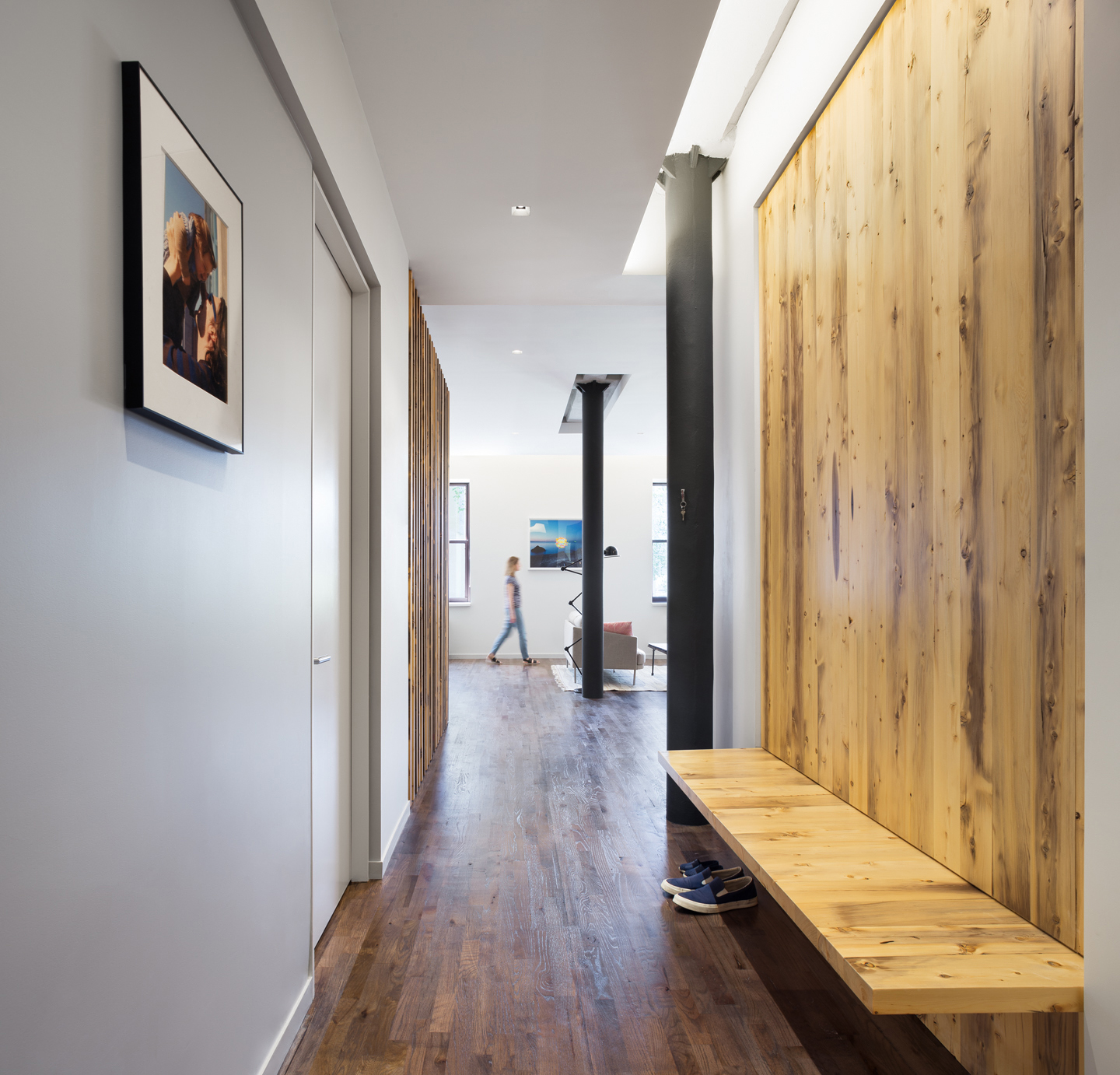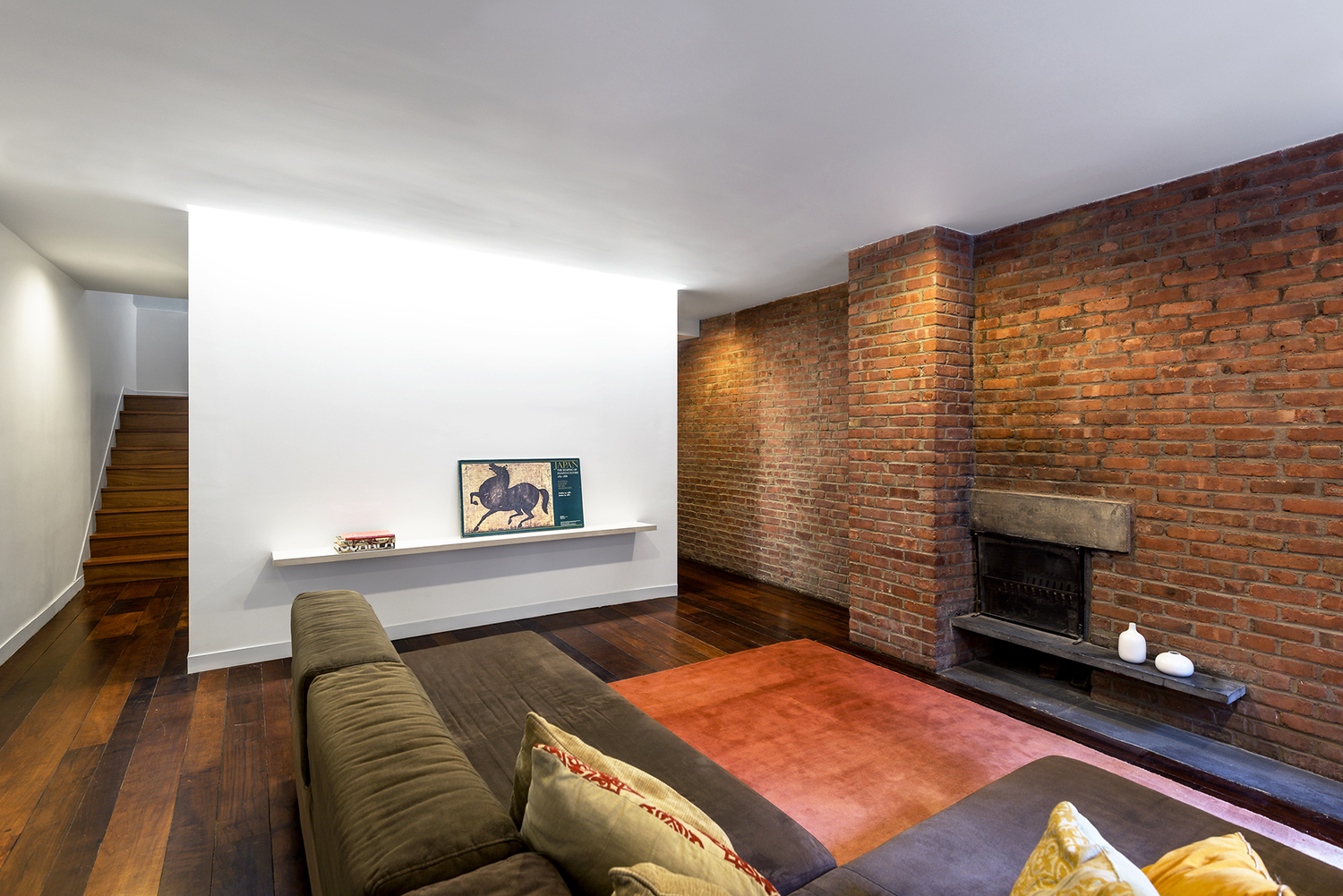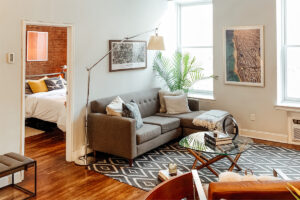
A Dumbo loft combined by Studio Modh. The ceiling was dropped to unify the two spaces and absorb the finish differences. All photography by Devon Banks.
The apartment combination is a uniquely New York project. Why leave a building you love when you can punch through a wall of a suddenly-available apartment and have something much bigger?
As simple as it may seem, combining apartments can be a tricky undertaking. There’s the due diligence, the likely need to reconcile the finishes and qualities of past renovations, and, as architect Andrew Franz points out, “addressing proportions and circulation so it doesn’t feel like you just punched through the wall.”
Ultimately, the goal should be to end up with a space that is greater than the sum of its parts. Here are some insights and tips for your apartment combination project.
What Are the Opportunities of Combining Apartments?
What’s especially exciting about these projects is not just the additional real estate, but also how it gets used. No matter the size of the units you’re combining, you’re going to have a lot more room to play with. Franz points out that this allows you to rethink the way space should be used in today’s context. Case in point: reworking the kitchens of prewar apartments. “The kitchens were often small because they were for staff and servants,” Franz says. “People are moving the kitchen to be adjacent to the living area. There’s also opportunity to reclaim living space that’s too large. That formal dining room that was essential to a 1920s apartment, for example, may be converted into a large, gracious kitchen with a butler’s pantry,” he says.
One thing to look out for is the placement of windows. Can you get exposure in more than one direction? “It can be a game changer,” says Franz. “In some ways, the views are more valuable than the additional square footage.” One project he recently completed made it possible to see the Hudson River from the front door. The additional walls of windows will help Franz determine the optimal layout. The places that are used most — typically, the living areas — get the prime views. “Harvesting greater views and giving them the premium exposure changes the value and experience of the apartment,” he says.
Ask Yourself: How Do You Want to Live?
Regardless of the size, this type of project offers the opportunity to create a home especially for you. My firm just started construction on a project on the Upper East Side where the clients knew they wanted more communal space. But along the core of the unit, there’s a game and media room, which was also a priority for the clients, because they have two young children who want a place where they can hang out with friends.
Philip Ryan, of Brooklyn’s Studio Modh, recently completed a loft in Dumbo where the clients opted for something more open. “I think when you do this, it can be great when you can question how they might live,” he says. “Does every function need to reside within a room with a door? Or can you utilize more horizontal volume so that it feels more generous?”
Making the Combined Apartment Look Original
Depending on the units, you may have two that are quite similar. But the older the building, the more likely that each unit has been renovated in varying styles and quality levels. “Obviously a goal is to make the client and their future guests feel like the unit has always been one space,” Ryan says. “Finding cost-effective ways to blend potentially two disparate spaces formally and stylistically can be a challenge.” For the Dumbo loft, the units to be combined were the products of separate renovations over the years. Among the solutions: instead of replacing three types of wood flooring, they experimented with a tinting formula to create a more consistent match. The ceiling was also dropped to unify the space and absorb some differences in finish where the old wall used to be.

Another view of the Studio Modh-combined loft in Dumbo.
Ideas to Make the Most of Your Combination Project
Look at the special qualities inherent in the building. “Having more space means also being able to mine the building for more horizontal vistas and to be able to pick up on formal repetitions that make spaces feel larger and enable you to understand the apartment in the context of the envelope of the building,” Ryan says. At the Dumbo loft, all the cast-iron columns were buried within walls. Between the two apartments, they were able to expose three of four columns.
Pay close attention to the lighting. You may end up with more space to fill near the core. The ideal is to balance that with the light coming from the windows, Ryan says. He also advises that you use artificial light indirectly: reflect it off walls, or uplight ceiling coves to reduce glare and balance daylight.
Be sure to work with an architect experienced in combining units and try to see a few examples in person. This is especially important to getting the layout right — one that’s intuitive and intentional, as if what’s there has always been there. It may add to the cost, but if you’re even remotely thinking about resale, keep in mind that no matter how big the unit, an awkward layout where monthly maintenance fees are higher than most (these get combined, too) will likely be a harder sell.
A Bit of Due Diligence Before You Begin
The good news about an apartment combination is that it’s a relatively straightforward process with the Department of Buildings. In our experience, it’s usually a standard renovation alteration permit. There’s no need to adjust the certificate of occupancy so long as the apartments are on the same floor or adjacent.
Franz reminds us that there is a difference between combinations in co-ops and condos. Co-ops tend to be simpler; with condos, you have to file with the Attorney General’s office to amend the tax law. “This can introduce more consultants and time,” Michale Franz says.
Also take time to investigate what’s going to be involved with the electrical work, and budget accordingly. “Combining panels and getting electrical up to code can be costly, but is important for a safe installation,” Ryan says. What can you expect? We’ve seen figures of $30,000 for a typical combination of two 2-bedroom apartments.
One good tip for any renovation: “Be clear on what’s allowed in your building; buildings can be very strict on months when you can do construction,” Ryan says. He also reminds us that every building is different — having a good relationship with the building manager and board is key to a successful project.
Don’t Wait — Bite the Bullet
Sometimes clients take measures to reduce costs, such as a longer-term combination, where you take on portions of the work now, and do the rest at a later date. Franz advises against it: “Invariably, that ends up costing more. You want to optimize the size of the project so you get more value out of the contractor. You will pay a premium to have them come back.”
The other is living in the space during construction (which would seem feasible if you don’t really need to touch a given portion of the place, right?). Ryan is pretty direct with his point: “Don’t do it. It’s unsafe, unhealthy, and it ultimately slows the construction down, resulting in added cost. It also creates a very stressful relationship between the owner and contractor. Owners never appreciate how violent the act of construction can be, and it can be quite emotionally difficult. Additionally, even the best contractor cannot adequately control the flow of dust.”

A duplex combined by Studio Modh on the Upper West Side. Photo courtesy Giles Ashford Photography.
Is Combining Apartments Really Worth It?
Whether it’s your forever home or you’re keeping an eye on resale value, you may find in your research that it actually makes more financial sense to just look for a new place. This StreetEasy forum is one place where people debate the pros and cons of combining apartments.
But if you’re set on making it happen, keep this argument in mind. “Recognize the difference (and importance) of the intrinsic value of designing a space for your life versus the real estate value,” Ryan says. “Sometimes the money you put in will improve your life, but may not necessarily get paid back when you sell the place. It’s very frustrating how expensive it is to do work in NYC, because it limits us. The cost of everything here makes it difficult. A lot of clients … take into account financial outlay in relation to investment. But it’s important to remember the value to improving your daily life. Design improves your way of behaving, and that has a value, too.”
—
Hey, why not like StreetEasy on Facebook and follow @streeteasy on Instagram?
Related:









